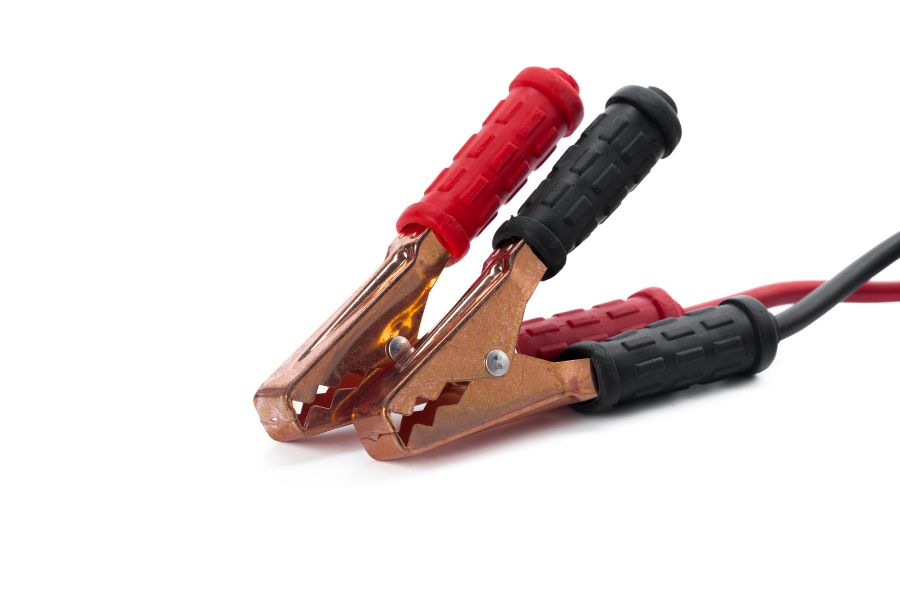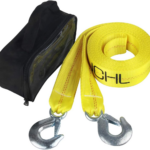A dead battery can leave you stranded, but with the right precautions and technique, you can safely jump-start your classic R107 and get back on the road. This guide follows Mercedes-Benz factory recommendations to ensure a safe and proper jump-start while protecting your vehicle’s electrical system.
Precautions Before Jump-Starting
⚠ Safety First!
- Never allow vehicles to touch during the process.
- Inspect jumper cables for damage; they must have intact insulation and strong clamps.
- Ensure proper battery venting—vent caps should be tightly secured.
- Place a damp cloth over battery vent caps (but keep it clear of moving parts).
- Avoid flames, sparks, and smoking—batteries emit flammable hydrogen gas.
- If the battery is frozen (approx. -10°C or +14°F), do not jump-start it—thaw it first.
What You Need
- A working 12V vehicle battery (from another car).
- Jumper cables (Minimum: 25 mm² or 2 AWG, Maximum length: 11.5 feet / 3.5 meters).
Step-by-Step Jump-Starting Process
Step 1: Position the Vehicles
✔ Park the assisting vehicle close enough for the cables to reach, but ensure the vehicles do not touch.
✔ Engage parking brakes on both vehicles.
✔ Turn off engines, lights, and accessories, except for hazard flashers or work lights.
Step 2: Connecting the Jumper Cables
1️⃣ Connect the Positive (+) Cable
- Attach one end of the red jumper cable to the positive (+) terminal of the good battery.
- Attach the other end of the red cable to the positive (+) terminal of the dead battery.
- Ensure clamps do not touch metal surfaces to avoid sparks.
2️⃣ Connect the Negative (-) Cable
- Attach one end of the black jumper cable to the negative (-) terminal of the good battery.
- Attach the other end of the black cable to a metal bracket or unpainted part of the engine on the car with the dead battery.
- Do NOT attach the negative cable to the dead battery’s terminal! This prevents sparking near the battery, reducing explosion risks.
Step 3: Start the Engines
✔ Start the car with the good battery and let it run at high idle for a minute.
✔ Start the car with the dead battery—if it doesn’t start immediately, wait 30 seconds and try again.
✔ Once started, let both cars run for a few minutes to charge the dead battery.
Step 4: Removing the Jumper Cables (In Reverse Order)
1️⃣ Remove the black (negative) cable from the metal bracket/engine of the previously dead vehicle.
2️⃣ Remove the other black (negative) cable from the assisting vehicle’s battery.
3️⃣ Remove the red (positive) cable from the dead battery.
4️⃣ Finally, remove the red (positive) cable from the assisting vehicle.
⚠ Avoid touching metal parts while disconnecting the cables!
Final Checks After Jump-Starting
✔ Let the engine run for at least 15 minutes to recharge the battery.
✔ If the battery repeatedly dies, have it tested—it may need replacement.
✔ Check for corroded terminals and tighten loose connections to prevent future issues.
Avoid Common Jump-Starting Mistakes
❌ Do not reverse cable connections—this can cause electrical damage.
❌ Do not let clamps touch each other or metal parts while connected.
❌ Never jump-start a frozen battery—it can explode.
❌ If the car doesn’t start after a few attempts, do not crank excessively—wait and try again.
By following these Mercedes-Benz-recommended procedures, you can safely and effectively jump-start your R107 while preventing electrical or battery damage.



